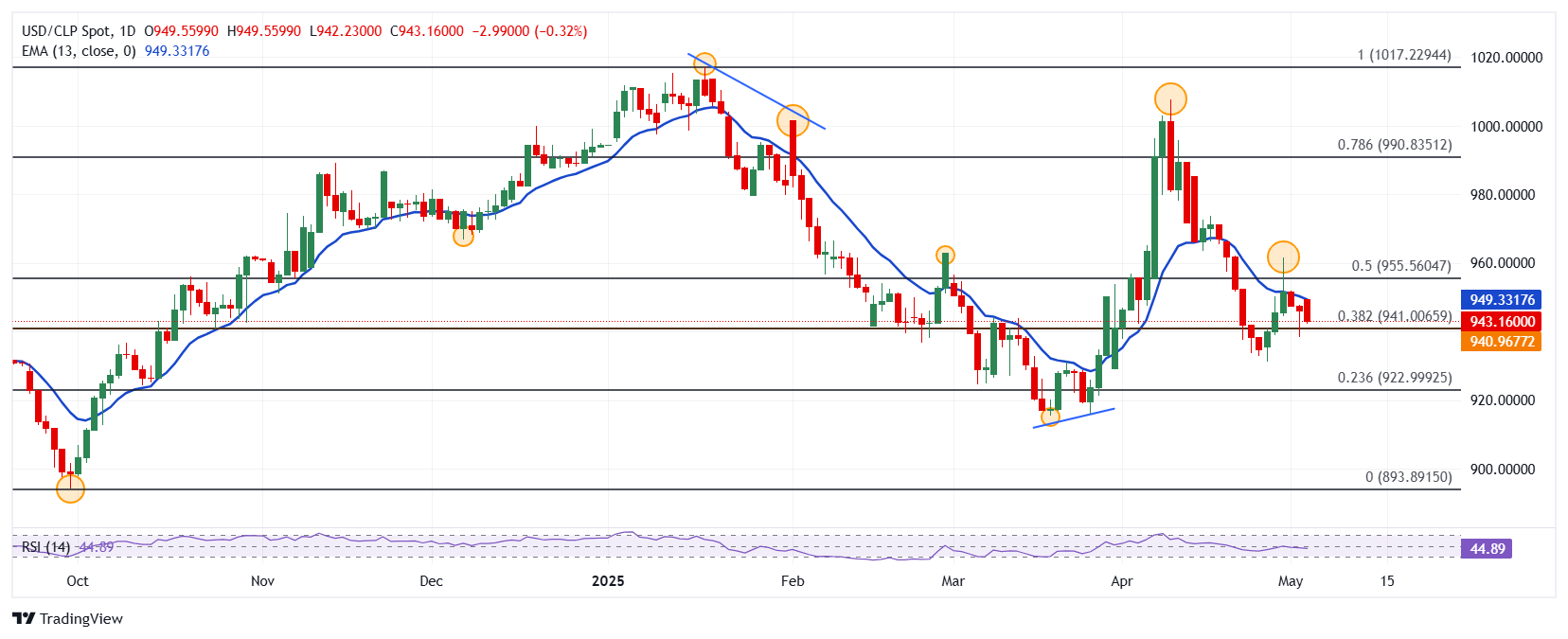- The US dollar loses ground compared to Chilean peso, quoting when writing about 943.66.
- The dollar index (DXY) falls 0.38% today, currently operating in 99.64.
- The price of copper has a 0.20% gain on Monday, consolidating at maximum April 30 at $ 4,6987 per pound.
- The PMI is services of the April ISM is 51.6 points, improving the expectations of analysts.
- The focus of investors will be on the decision of interest rates of the Federal Reserve on Wednesday, the consensus expects to remain unchanged by 4.5%.
The USD/CLP marked a daily maximum in 949.55, where it found vendors who led parity to a minimum of the day at 942.23. At the moment, the USD/COP decoced 0.27% today, operating at 943.31.
The Chilean weight extends profits after the ISM services PMI of the United States
According to the United States Office Administration Institute, the PMI of Services increased to 51.6 points in April, exceeding the estimates of 50.6 and the previous registration of 50.8.
After this result, the dollar index (DXY) falls 0.38% daily, consolidating within the range of Friday’s session at 99.66, spinning two consecutive days down.
On the other hand, the price of copper rises 0.20% in the day, reaching maximum of April 30 in $ 4,6987 per Libra, signing its third consecutive session with profits.
In this scenario, the Chilean weight operates in positive terrain, while the USD/CLP falls 0.27% on Monday, consolidating within Friday’s operational range at 943.31.
The attention of investors will be on Wednesday on the decision of interest rates by the Federal Reserve. The consensus of analysts projects that it remains unchanged by 4.5%, while the Fedwatch tool of the CME throws 95.6% probability that is located in a range between 4.25% and 4.50%.
Technical levels in the USD/CLP
The USD/CLP established a short -term resistance given by the maximum of April 30 in 961.65. The next important resistance is observed at 1,007.73, maximum of April 9. To the south, the key support is located at 915.57, a pivot point of March 19.
USD/CLP daily graphics

US dollar FAQS
The US dollar (USD) is the official currency of the United States of America, and the “de facto” currency of a significant number of other countries where it is in circulation along with local tickets. According to data from 2022, it is the most negotiated currency in the world, with more than 88% of all global currency change operations, which is equivalent to an average of 6.6 billion dollars in daily transactions. After World War II, the USD took over the pound sterling as a world reserve currency.
The most important individual factor that influences the value of the US dollar is monetary policy, which is determined by the Federal Reserve (FED). The Fed has two mandates: to achieve price stability (control inflation) and promote full employment. Its main tool to achieve these two objectives is to adjust interest rates. When prices rise too quickly and inflation exceeds the 2% objective set by the Fed, it rises the types, which favors the price of the dollar. When inflation falls below 2% or the unemployment rate is too high, the Fed can lower interest rates, which weighs on the dollar.
In extreme situations, the Federal Reserve can also print more dollars and promulgate quantitative flexibility (QE). The QE is the process by which the Fed substantially increases the flow of credit in a stuck financial system. It is an unconventional policy measure that is used when the credit has been exhausted because banks do not lend each other (for fear of the default of the counterparts). It is the last resort when it is unlikely that a simple decrease in interest rates will achieve the necessary result. It was the weapon chosen by the Fed to combat the contraction of the credit that occurred during the great financial crisis of 2008. It is that the Fed prints more dollars and uses them to buy bonds of the US government, mainly of financial institutions. Which usually leads to a weakening of the US dollar.
The quantitative hardening (QT) is the reverse process for which the Federal Reserve stops buying bonds from financial institutions and does not reinvote the capital of the wallet values that overcome in new purchases. It is usually positive for the US dollar.
Source: Fx Street
I am Joshua Winder, a senior-level journalist and editor at World Stock Market. I specialize in covering news related to the stock market and economic trends. With more than 8 years of experience in this field, I have become an expert in financial reporting.







